The Begonia maculata plant, also known as Polka Dot Begonia, Polka Dot Plant, Dragon Wing plant, Angel Wing plant, or spotted Begonia, is an interesting plant with a distinct look that necessitates a lot of water. Its leaves are dark green in hue and feature silvery specks. It’s simple to look after. It requires a lot of light and weekly irrigation to keep the substrate wet. While the specks that emerge on its leaves are its main feature, they may also produce little white flowers that are quite lovely if properly maintained. In this article, we tell you everything about Begonia maculata wightii Polka Dot Begonia: How to Care & How to Propagate Begonia maculata. All the tips about the Polka Dot Begonia propagation. Also, as requested by our readers, we will sneak into the Pink Begonia maculata.
Table of Contents
Begonia maculata wightii – Polka Dot Begonia Care & How to Propagate Begonia maculata
Polka Dot Begonia Propagation & Care. Many readers and gardeners wonder whether the different names for Begonia maculata are just different names or whether they are different plants. So, before we go over the details about how to care for and propagate Begonia maculata, let’s review a bit of the name this plant goes by.
The genus is “Begonia”, and the specific epithet is “maculata” (meaning spotted). The species is the combination of the genus and the specific epithet; therefore, the species is Begonia maculata, and the common name is Polka Dot Plant (one of the many names given to this plant).
Now, botanists who began to classify this plant in about 1850 from the species found in Brazil, have reported different varieties of Begonia maculata.
Some scientific names of these Begonia maculata varieties have become more popular, but in practical terms, the varieties of this species have almost imperceptible differences.
So, when gardeners expect to find differences between Begonia maculata vs Begonia maculata wightii, or differences between Begonia maculata vs Angel Wing, or Polka Dot Plant, in reality, we are all talking about exactly the same plant. Below there are a few names for the different varieties of Begonia maculata where “var.” means varieties.
Begonia maculata var. elegantissima, Begonia maculata f. argentea, Begonia maculata var. wightii, and Begonia maculata var. argentea. All these, are popularly named Polka Dot Plant.
For its stunning beauty, the Begonia maculata plant is also known as the spotted Begonia, the Dragon Wings plant, the Angel Wing plant, Begonia maculata wightii, and the Polka Dot Begonia.
The most popular commercial variety distributed in the United States is the Begonia maculata wightii plant (Polka Dot Plant)
The care of Begonia maculata wightii is not different from the care needed for other Begonia maculata varieties, but it is very different from the care needed for other types of Begonias.
Likewise, the propagation of Begonia maculata wightii is not different from the care needed for other Begonia maculata varieties.
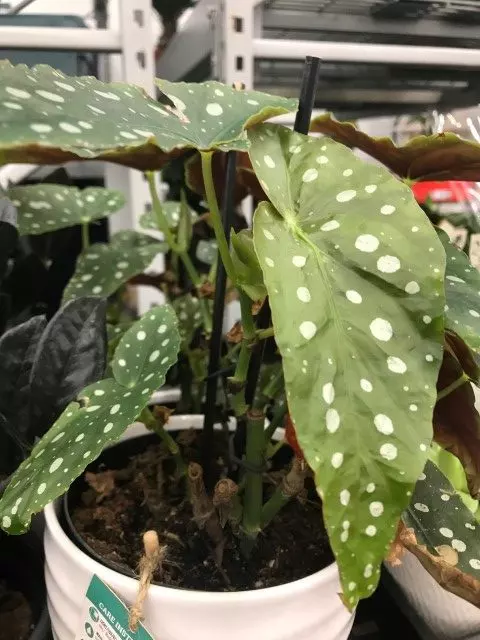
Begonia maculata Care
Begonia maculata or Begonia maculata wightii is becoming popular because of the beauty of its large olive-green leaves arranged as Angel wings, surrounded by silver polka dots. The leaves are in red or maroon color and provide an attractive contrast to green leafy foliage. We begin by briefly discussing Begonia maculata care – Polka Dot Begonia Care.
Knowing how to care for Begonia maculata is vital for keeping your specimen in top shape. They are not difficult tasks in Begonia maculata Care, but these guidelines must be followed to avoid difficulties.
Let’s review this Begonia maculata Care Summary and have the most important information.
How Much Light Does a Begonia maculata Need? Light for Polka Dot Plant
Let’s review the Polka Dot Begonia light requirements. How Much Light Does a Begonia maculata Need?
Begonia maculata enjoys being in the sun and may be exposed to it for several hours each day. It will develop quite quickly in this manner.
Although the Polka Dot Begonia may be placed right in front of a window, it would be best to set it in a room with plenty of light rather than directly in front of one.
Most species of the Begonia genus require abundant diffuse radiation but not direct solar radiation.
How to Water Begonia maculata? Polka Dot Plant Watering
How to Water Begonia maculata wightii. It is vital to water the Begonia maculata Polka Dot Begonia sparingly to avoid the substrate becoming soggy since this might negatively damage the roots.
How often should I water my Begonia maculata?
How often should I water my Begonia maculata? It’ll suffice if you do water the Begonia maculata plant once or twice a week.
Humidity For Begonia maculata
Medium-high humidity is the recommendation for Begonia maculata. The environment should be humid at all times but without reaching saturation.
It should be done with low hardness water (pH 4.5-5) at room temperature. In summer, begonias, in general, should be watered once the substrate is dry between one watering and the next. Begonia rex, on the other hand, does not require the substrate to dry out between waterings.
During autumn-winter, the frequency of watering decreases, and watering is done only when the substrate is completely dry. As soon as the leaves fall off, watering is canceled.
How to Water Begonia maculata in Pots? Potted Polka Dot Plant Care
How to Water Begonia maculata in Pots? When it is a potted Begonia maculata the most convenient way to water is always after verifying the humidity of the soil.
The Polka Dot Begonia plant needs abundant moisture in the soil. However, this can be a determining factor causing the plant to get sick due to the development of fungi and bacteria.
Once the plant has had an excess of humidity and its roots are diseased, it will begin to show signs of deterioration in the leaves. This critical state may not be reversed.
To prevent overwatering of the potted Begonia maculata plant our recommendation before watering is to touch the soil surface and 1-2 inches above the surface. If it is dry, add water, a small amount. If it is wet, do not water it. There is no recommended frequency for watering potted Begonia maculata.
The frequency depends on the ambient humidity and temperature, number of leaves, air currents such as cooling and heating, pot material, etc. Therefore, when watering potted Begonia maculata it is highly recommended to first check the moisture content of the soil and then add some water if watering is necessary.
Water should never be sprayed on the leaves of the Begonia maculata plant, regardless of whether it is a potted Polka Dot Begonia plant or not.
Potted Polka Dot Begonia Plant
When the Polka Dot Begonia plant is intended for indoor plants, the pot should be 4-5 inches (10-12 cm) in diameter.
Pruning Begonia maculata Polka Dot Begonia
How to prune the Polka Dot Begonia plant. How to Trim Begonia maculata. If a leaf dries up, it should be removed to prevent the remainder of the plant from suffering. Its branches may be trimmed to give it the form you choose. It won’t cause any serious issues.
Normally cleaning pruning and trimming are recommended for Begonia maculata. In the case of bushy begonias, which are too tall or have been left untrimmed in the center, they should be pruned intensively in spring, before the onset of budding.
Soil for Begonia maculata and pH for Polka Dot Plant
A universal substrate created for indoor plants can be used as a substrate for Begonia maculata. Changing it regularly can improve nutrient absorption and make the Begonia maculata plant glossier.
The best substrate for most begonias is a mixture of peat, bark, and sand in a 2:2:1 ratio and with good drainage. The pH should be between 5.5 and 6.5. Learn more about How to Measure Soil pH.
Soil pH for Polka Dot Plant. When the soil pH is not correct leaves begin to lose luster and change color due to obvious nutritional deficiencies in the plant. When soil pH is inadequate, nutrients are not available to nourish the plant and causing plant disease and leading to the spread of pests.
- Blended for a wide variety of container plants
- Feeds up to 6 months
- Designed to be less prone to gnats (Contains no compost or bark, which are known to shelter fungus gnats)
Temperature for Begonia maculata
Temperature for Begonia maculata. Another factor to consider is the temperature of the surrounding environment. Begonia maculata should constantly be kept at a temperature of approximately 68 F (20 C), otherwise, it will be harmed.
The optimum temperature for the development of Begonia maculata is between 64.4-78.8 F (18-26 C).
In any event, should be exposed to frost or freezing temperatures.
At the marketing stage, the Begonia is stored for about four days, the optimum storage temperature being 50-59 F (10-15 C).
Begonia maculata Flowers
Begonia maculata Flowers. They may bloom the entire year. However, Begonias, sadly, do not live for very long. It will decline with time, even if you take careful care of it, but it is a one-of-a-kind and necessary plant in any collection.
More about the Spotted Begonia maculata
Begonia maculata is one of the species that develop shrubby begonias.
The group of these shrubby begonias includes species mostly from tropical regions of Central and South America.
They are large plants, erect (except Begonia foliosa and Begonia limmingheiana with hanging growth) and very branched. They do not develop true wood although the most lignified stems have a woody appearance in the portion near the base.
The flowers, which appear in hanging clusters, are large, usually red or pink. Some are even fragrant.
The shape and coloration of the leaves show all the diversity that the Begonia genus has to offer, although they do not reach the splendor and beauty of the leaf begonias.
Shrub begonias, as well as Begonia maculata included in this group of shrub begonias, are very sensitive to drafts, places that are too cold, too hot, or too dark, waterlogging, and also to the dryness of the substrate.
The flowers of Begonia maculata are white and pink. The male flowers have four variable tepals in the same flower arranged in pairs. In contrast, female flowers have four equal tepals, which develop later. In general, male flowers are usually showier than female flowers.
The flowering period of Begonia maculata is from early summer to mid-autumn, although some species bloom all year round. The stem is fleshy with several knots along the stem and the leaves are asymmetrical, arranged alternately along the stem.
Begonia maculata Care Summary
Polka Dot Begonia Propagation
How to Propagate Begonia maculata
Polka Dot Begonia propagation. Let’s review How to Propagate Begonia maculata. Propagation of Begonias, species in general, depends on the type of root system they have.
How to Propagate Begonia maculata from Seeds
Polka Dot Begonia Propagation from Seeds
Polka Dot Begonia Propagation from Seeds. Let’s review How to Propagate Begonia maculata from Seeds. Seed propagation of Begonia maculata should be done in January and February.
Seeds should be evenly distributed in a finely sieved substrate of enriched peat and very fine sand moistened and slightly compressed to ensure good contact of the rootlets at germination.
Germination occurs after 10-15 days in the presence of light. As soon as germination occurs, spraying with a very dilute nutrient solution should be started.
As the plant grows, the demand for light gradually increases and the demand for temperature decreases to 64.4 F (18 C) for about a month.
How to Propagate Begonia maculata by Leaf Cuttings
Polka Dot Begonia Propagation from Cuttings
Some begonias are generally propagated by leaf cuttings (especially Begonia rex and Begonia masoniana).
This process consists of dividing a healthy leaf into several segments of about 3 cm, which must have at least one main nerve. Another option is by whole leaves, which are given a few small cuts in the main nerves and placed on top of a substrate composed of peat and perlite.
Let’s continue reading more about Polka Dot Begonia Propagation from leaves by cuttings
For rooting, the substrate tray should be placed in a place with diffused light (never with direct solar radiation), constant relative humidity, and a temperature of around 69.8 F (21 C).
After a month and a half, the new plants are born. As they grow, the light should be gradually increased until they are sufficiently developed to be transplanted.
Tip cuttings root at 77 F (25 C) in 2 weeks, while leaf cuttings take about 5 weeks.
Currently, in Begonia rex, in vitro propagation techniques are being carried out to easily obtain healthy plants without having to resort to the costly maintenance of mother plants.
Begonias with tuberous roots are usually multiplied by cutting or division of tubers in spring.
This process consists of planting the basal tubers in a substrate of sand and peat in a 1:1 ratio. Subsequently, they are kept at 20 C until the seedling reaches the right size for transplanting.
The decrease in temperature and the application of artificial light during short days have a notable influence on the elongation and flowering of these plants.
The quality of light during ethylene emission used for vegetative reproduction is also very important. Studies have shown that ethylene production can be controlled by reducing the aging effect by using white or red light. This type of light inhibits the formation of stimulators involved in ethylene formation in leaves.
Propagate Begonia maculata from Leaf Cuttings
Polka Dot Begonia Propagation
How to Propagate Begonia maculata from Leaf Cuttings. In the following paragraphs let’s review how to propagate Begonia maculata from leaf cuttings as this is a very simple method.
Cuttings can be used to grow Begonia maculata. Cut established branches and place them in a container with water until the roots grow, at which point they should be placed into a pot.
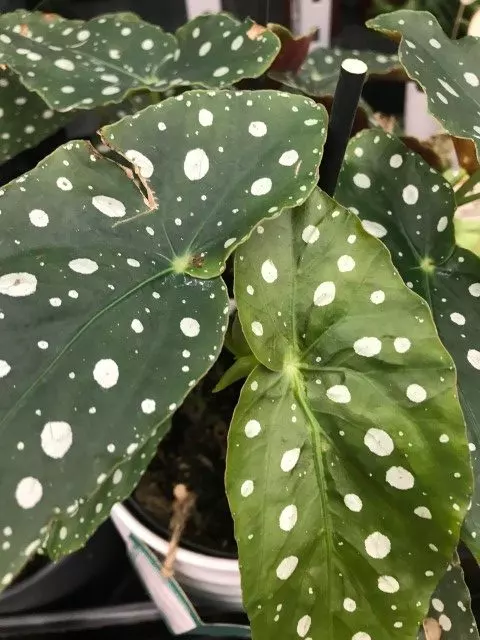
When to Propagate Begonia maculata from Leaf Cuttings
Polka Dot Begonia propagation from Leaf: When to Start?
When to Propagate Begonia maculata from Leaf Cuttings. Polka Dot Begonia propagation from Leaf: When to Start? The end of winter is the optimum time to accomplish this. The first roots will sprout around a month and a half later. Many individuals also inquire about the Begonia maculata bloom. Flowers are tiny and white to pinkish-white in color.
How to Grow Begonias from Leaf Cuttings
How to Grow Begonias from Leaf Cuttings. Begonias are very popular plants in gardens. Almost everyone who likes gardening has a specimen of these wonderful plants in his garden. Generally, when we have begonias at home, it is because we bought a small or already grown plant, but few of us have managed to reproduce these wonders at home.
The method we propose today to reproduce the spotted Begonia maculata is very easy and safe; in a few days, you will be able to enjoy new plants. Besides, it will not damage the mother plant because only one leaf with its petiole is needed.
The method of reproduction by leaf cuttings in begonias, generally only works in the species that have hairs on the petiole, but almost all the begonias that we grow at home are of this type.
The first thing to take into account for this method is the health of the mother plant because if it is diseased by a bacterial or fungal infection, the cuttings will rarely root.
First of all, we need the perfect cuttings for rooting. Commonly, the best cuttings are taken from the largest leaves of the plant, you should never use leaves that have just opened.
The length of petiole you need for the cutting to root depends on the size of the leaf. Always try to cut the cutting at the base of the petiole, although you don’t need the entire petiole, just 2/3 of the length of the petiole.
You should plant the spotted Begonia maculata in the substrate burying almost the entire petiole, just leave out a small fragment of the petiole and leaf.
The best substrate for rooting our cuttings consists of a mixture of peat, sand, and bark. You can use rooting hormones to increase the probability of success.
The cuttings should be kept at an average temperature of 77 F (25 C) and in about 5 weeks they will start to root.
It is very important during this time, not to expose the cuttings to direct sunlight, but it is good to keep them in well-lit places. Cuttings are usually very susceptible to any kind of pathologies so it is very important to keep them free of fungal infections, bacteria, insect attacks, or other animals.
Generally, plants born from this type of cutting are quite compact and very healthy. Do not hesitate to put this method into practice and in two months you will be able to enjoy your new begonias.
Polka Dot Begonia Propagation in Water
Begonia maculata Propagation in Water
Polka Dot Begonia Propagation in Water. Let’s review now how to propagate Begonia maculata in water. The Begonia maculata propagation in water by cuttings is one of the most effective ways to proliferate this species as well as a huge number of plant species. It is significantly faster than seed multiplication because once rooted, the cutting continues to grow from seedling to adult size over weeks or months, ensuring that we have an adult specimen that is a genetic clone of the parent plant, with all of its strengths and health.
Knowing how to root a cutting, on the other hand, is not always simple. Some plants are well-suited to this, while others require considerably more detailed attention for the cutting to flourish and develop. Continue reading this post to understand how to root cuttings using the most effective approaches.
Polka Dot Begonia Propagation in Water
Polka Dot Begonia Propagation in Water. Cuttings in water are, along with grafting, layering, and seeds, the most common methods of propagation. The technique consists of submerging the base of a shoot or the petiole of a leaf in water so that it develops roots. The plants that guarantee good results are those with soft, non-woody stems.
Propagate Begonia maculata in Water
Polka Dot Begonia Propagation in Water. The Begonia is a plant that can be reproduced using stem cuttings placed in water. As we always remind our gardeners, clean and sanitize your tools before cutting to prepare your cuttings. Make sure to disinfect the pruning shears with alcohol.
Choose the most suitable stem, based on the general health of the plant and the branch in particular. The success of propagation by cuttings will depend on how suitable and healthy your cutting is.
If temperatures are expected to be between 70-80 F (21-27 C) at the time of cutting collection, a fungicide should be applied.
Polka Dot Begonia Propagation in Water – Choose the Best Container
Choose glass containers for propagating Begonia cuttings in water. Avoid plastic containers to minimize colonization of surfaces by bacteria and fungi. The colorless glass prevents the formation of bacterial biofilms compared to plastic because glass provides a more sanitary surface.
- Dimensions - Height: 12" | Diameter: 4" | Pack of 1
- Quality - Hand-blown crystal clear glass not machine made. Crafted with thick glass and a stable bottom for the perfect table centerpiece.
- Uses - Cylinder Vases are the most simple, elegant glass vase centerpiece. Although they are common, they are the most effective decor for almost all occasions. It is both generous and befitting. Regardless if you are using in wedding events or home decor. It will easily attract attention to its elegance.
It is recommended that the water reservoir is not only clean but also filled with mineral water from a bottle at this first opportunity. In this way you will provide a good quantity of nutrients and minerals to the cutting, facilitating its adaptation to the environment.
In addition, bottled mineral water lacks chemicals such as bleach additives in traces in tap water for human consumption but is very impacting and counterproductive in the propagation of Begonia maculata.
All that remains is to place the Begonia cutting in water and wait for the new roots to sprout, taking care to keep the water in the container fresh and clean.
Polka Dot Begonia Propagation in Water. Like any bulbous plant, the best way to propagate a begonia is to divide bulbs that have buds, leaving at least one bud on each new cutting. Before planting, it is best to allow the cut to heal.
Propagation Begonia maculata With Rooting Hormone
For cuttings, make your rooting hormone.
Polka Dot Begonia Propagation with Rooting Hormone. The rooting hormone is one of the most essential tools when it comes to rooting cuttings. These are products that increase the root’s ability for development, allowing and speeding up the rooting of the cutting.
You can buy rooting hormone at most gardening stores, but we always recommend going the natural route and making your rooting hormone at home with natural ingredients.
It’s simple to create, and all you need is a little planning ahead of time before cutting the plant. Auxins are the plant hormones we seek when we’re trying to figure out how to root rapidly.
These may be found in a variety of legumes and sprouted grains, so making them using lentils, soybeans, chickpeas, and a variety of spices is straightforward.
- PROMOTES ROOTING: Rooting hormone grows new plants from cuttings.
- GROW CUTTINGS: Works with most popular home, garden and greenhouse varieties.
- ROOT NEW FAVORITE PLANTS: Helps African violets, roses, poinsettias, philodendrons, geraniums, coleus, woody ornamentals and more grow from cuttings.
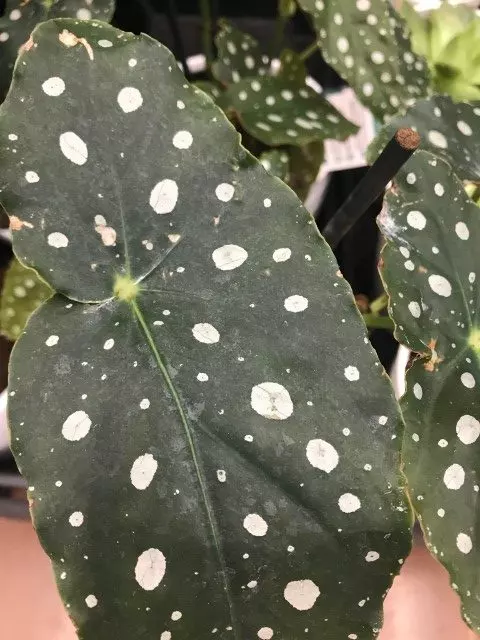
Making Rooting Hormone: A Step-By-Step Guide
Homemade Rooting Hormone: A Step-By-Step Guide. Make sure the legumes are ready to germinate. Chickpeas, lentils, and soybeans are the most frequent. Prepare one part of legumes for every four parts of water, and place them in a jar with a lid or a towel to cover them.
Keep the container out of the way and away from light, especially the latter.
Your legumes should have mainly germinated after three or four days.
This is the perfect moment to smash them with the water in which they germinated, draining and filtering the combination, which will be our auxin-rich DIY rooting hormone.
To make your hormone, dilute the concentrate in nine parts of water for each component of the hormone.
Rooting hormone could be commercially prepared or could be homemade rooting hormone by you as explained in this link in our step-by-step guide.
Polka Dot Begonia Propagation Using Rooting Hormone
What Is the Best Way to Utilize Rooting Hormone?
Polka Dot Begonia Propagation Using Rooting Hormone. Rooting hormone can be used in two ways:
The first option is to soak the cuttings in the auxin mixture for an hour once they are ready to be planted. Then, take them out of the container and plant them in their pots or the soil as usual, because they will have absorbed the impact of the preparation because they are moist.
The second option is to plant the cuttings normally and then water the plants with the diluted hormone. The advantage of this approach is that it lasts longer, but it needs a consistent supply of rooting hormone, as the combination can only be maintained in the refrigerator for about 15 days before losing its positive properties.
Proper Environment for Rooting Cuttings
Polka Dot Begonia Propagation Using Rooting Hormone. Rooting cuttings in the right environment. Giving the rooted plant a proper habitat is just as important as injecting rooting hormone or allowing the wound to heal. After the cutting has been made, the plant must have three main pillars: warmth, light, and humidity.
Place the cuttings in a well-lit place with the appropriate humidity and a temperature that is not too cold. Avoid flooding the cuttings with water. Plastic bottles or containers are commonly used to cover the cuttings, which helps to preserve the soil’s humidity and regulate the temperature.
How Long It Takes for The Cuttings to Root
Polka Dot Begonia Propagation Using Rooting Hormone. The length of time it takes for each plant to root varies depending on the species and climatic circumstances, but if everything goes well, any cutting should root in fewer than 15 days, though some do so considerably faster. If your cutting is still not sustaining itself with its roots after two weeks, the technique has most likely failed and you will need to start over.
Begonia maculata Repotting and Transplanting
Polka Dot Begonia Propagation, Seedlings Transfer, and Repotting
Polka Dot Begonia Propagation, Seedlings Transfer, and Repotting. Whether is repotting or just transplanting seedlings the recommendation is to move them before the roots have developed too much.
Let’s review a few details when repotting Begonia maculata or transferring seedlings. The growing soil should be good, rich in humus, and well-drained.
Polka Dot Plant Repot. The tuber is usually left in the pot during the winter period. In spring it is planted, leaving the bud upwards in a slightly acid substrate. Subsequently, the light intensity is gradually increased. When the first shoots are born, they are carefully transplanted into a peat substrate.
During the rooting period, complete fertilizers with microelements (2g/l) should be applied. In the production period, especially in begonias with a high number of flowers, a fertilizer rich in potassium (K) should be applied.
Sometimes leaves turn pink, and it may seem like a Pink Begonia Maculata (Begonia roseopunctata) but it is not. Pink Begonia Maculata has pink dots, instead of white dots. Some Polka Dot Begonia change their leaves’ color when fertilizer is needed.
Normally commercial fertilizers with a 2:1:2 balance plus micronutrients are used and can be changed to a 2:1:3 balance two weeks before the sale.
Enriching the atmosphere in CO2 (600 ppm) during the rooting period may increase the development. How to do that? Just cover the seedlings wrapping with plastic film or use a bag. The atmosphere inside the wrap will increase in CO2 content rapidly.
During plant senescence, ethylene inhibitors are used to control flower and leaf drops.
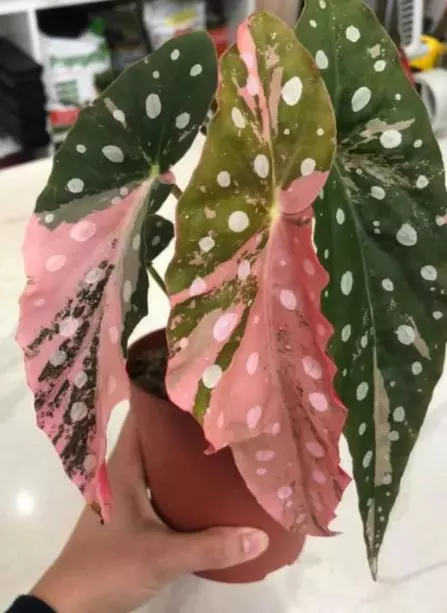
Begonia maculata Care: Diseases and Pests
Polka Dot Begonia Propagation Pest Control
Polka Dot Begonia Propagation Pest Control. In the following paragraphs, we will review some pests that can affect the Polka Dot Begonia plant and how to control them.
– Whitefly (Bemisia tabaci): it occurs mainly when temperatures reach 77 F (25 C). Symptoms are yellow spots and wilting. Symptoms are yellow spots and wilting of leaves.
Control of Whitefly (Bemisia tabaci): to avoid/prevent severe whitefly attacks, yellow chronotropic traps should be placed on the plant. If the attack is more severe, a combination of chemical and biological methods (parasitoids, predators, or even insect pathogenic fungi) is currently being used.
– Nematodes (Aphelenchoides fragariae): Phytoparasitic species of this genus are unable to complete their life cycle in the soil, so they are found on leaves, stolons, bulbs, and seeds. In begonia, they complete their cycle on leaves in 10-11 days at a temperature of 64.4 F (18 C).
Symptoms are manifested by the appearance of nerval reddening, which subsequently spreads throughout the leaf. Necrosis does not appear. However, if there is a joint effect of this nematode with Xanthomonas begoniae, the damage is greater, resulting in the presence of necrotic spots.
These nematodes move through water films on the leaves and penetrate through the leaves through stomata, insect bites, etc.
Control of Nematodes (Aphelenchoides fragariae): the spread of the nematode can be facilitated by: splashing water, contact between plants, pruning tools, etc.
For control, preventive measures should be applied, such as disinfection of all types of tools, elimination of weeds that can act as a reservoir, avoiding water splashes, etc. Chemical control is not efficient.
Let’s continue reviewing in the following paragraphs some diseases that can affect the Polka Dot Begonia plant and how to control them.
– Botrytis cinerea: This fungus needs wounded or senescent tissues to affect the plant, as well as environmental humidity and high temperature. Symptoms may appear on leaves, petioles, and flowers and are easily identified in the field by its characteristic gray, hairy sporulation on the leaf and flower faces.
Control of Botrytis cinerea: the control of this fungus is very important due to its ability to survive as a saprophyte. Excessive humidity should be prevented by lowering watering dose and frequency, spacing the plants, or ventilation. It is also recommended to remove unhealthy tissues by cutting them at the stem level with sanitized equipment.
Chemical control should be utilized if the attack is severe. Alternate use of the several systemic categories of approved drugs is advised.
– Pythium: This fungus is transmitted through the substrate or irrigation water. The infection starts at the soil level and spreads along the trunk causing tissue rot.
Control of Pythium: As a preventive measure, a disinfected substrate should be used and contaminated water should be avoided.Chemical control is a good option that should be utilized if the attack is severe.
– Leaf spot (Myrothecium roridum): this is a common soil-dwelling saprophyte that is pathogenic to susceptible hosts under favorable environmental conditions. It produces conidia in characteristic sporodochia, approximately 1-2 mm in diameter.
Symptoms manifest as circular leaf spots that later acquire irregular shapes of approximately 1 in (2.5 cm) in diameter. The lesions usually occur at a particular point, but eventually spread along the leaf veins. The center of the spot may be lighter brown than the edge and the lesion may be darker on the upper side than on the underside of the leaf.
Control of Leaf spot (Myrothecium roridum)
Polka Dot Begonia Propagation Pest Control. The presence of this disease can be prevented by avoiding excess moisture, and unnecessary wounding, and promoting the rapid formation of peridermic in the wounds after the cuttings have been harvested.
– Powdery mildew (Oidium begoniae): This fungus thrives in a dry environment. Normally, it does not cause death to its host, but powdery mildew colonies quickly make the plant unmarketable.
Symptoms can be observed on leaves, petioles, peduncles, and flowers. White spots appear on the upper side of the leaf, which later turns yellowish. These spots spread and necrotize, resulting in leaf curling and leaf death. White mycelium can be observed on the underside of the leaves.
Control Powdery mildew (Oidium begonia): As a preventive measure, ventilation of the plant is favorable for reducing the potential for infection, but large air currents should not be created.
Once the plant is diseased, the damaged parts of the plant should be removed.
If the attack is severe, the use of chemical products with fungicidal action, such as sulfur powder, can be used. On the other hand, biological control can also be used, with the hyperparasite Ampelomyces quisqualis. This usually works best in combination with a fungicide.
– Xanthomonas campestris pv. begoniae: This is a bacterium that causes the rotting of stem and leaf cuttings. When the environment is very humid, this bacterium invades the vascular system, causing various spots. These are oily spots on leaves that spread rapidly.
Infected plant materials are probably the most important source of contamination, as this bacterium can survive on foliage for several months before disease initiation.
Control of Xanthomonas campestris pv. begoniae: Chemical control is inefficient, hence the importance of preventive measures. It is important to ensure the health of the mother plant, disinfect all types of material (pruning tools, substrate, pots, irrigation system, etc.), eliminate plants with foliar spots, and avoid handling wet foliage.
– Crown gall (Agrobacterium tumefaciens)
It is a bacterium that forms galls usually in the crown, although occasionally they can also appear in roots, stems, or branches. The galls appear as small masses of callus tissue, which subsequently enlarge.
Control of Crown gall (Agrobacterium tumefaciens):
Polka Dot Begonia Propagation Pest Control. If the attack is severe, plants affected by this disease should be discarded. They should be treated with cupric products and the soil should be disinfected with steam.
Scientific research demonstrates that Agrobacterium radiobacter, strain K84 seems to be a suitable biological control of crown gall.
– Tomato spotted wilt virus, known with the acronym TSWV and Impatiens necrotic spot virus known with the acronym INSV.
Vegetative multiplication of Begonia has resulted in the perpetuation of numerous viruses in the offspring. There are no viruses particular to Begonia plants and all viruses isolated in this species are ubiquitous viruses found in other ornamental plants. The manifestations of these two viruses are very similar.
The most characteristic and severe symptoms consist of concentric discolored spots that necrotize very rapidly leading to desiccation of most of the leaf surface. Flowers may also show necrosis that compromises their opening. Occasionally, deformations or accentuated pigmentation of the leaves are observed. Diseased plants, in their juvenile stage, inevitably die.
Control of TSWV and INSV: for the control of this disease, it is necessary to fight against the thrips, since it acts as a vector of these viruses. If there are plants/leaves with suspicious symptoms of this disease, they should be discarded. It is important to ensure the quality of the plant material.
Is Begonia maculata Toxic to Cats or Dogs?
The Begonia maculata plant and its varieties such as Begonia maculata wightii can cause nausea, vomiting, and diarrhea in dogs and cats. Begonia maculata is toxic to dogs and cats and can even cause death.
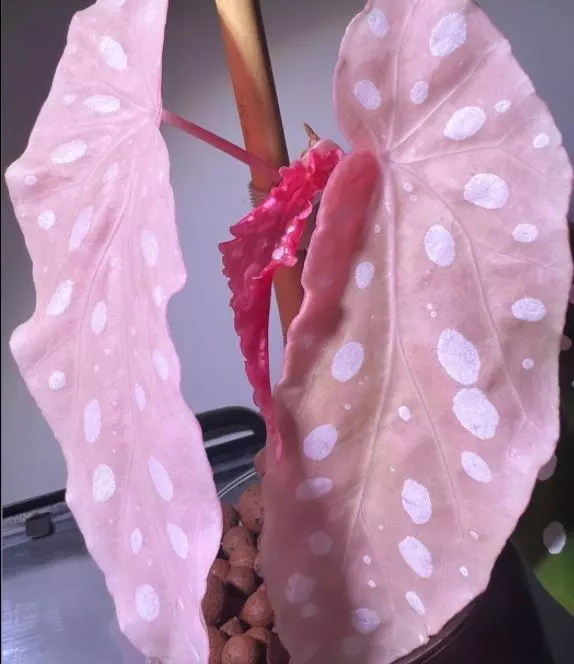
Where can I buy Begonia maculata?
Begonia maculata wightii is available in online stores (Order here).
Also, there are other Begonias of the Angel Wing type that instead of having white dots have pink, red dots, and the leaves present mutant characteristics being pink, instead of olive green.
- All of our listings have very representative pictures of what you will receive.
- This plant comes fully rooted in a 6" pot, ready to grow in your beautiful home or office!
- California Tropicals
- Plants may come in White or Gray ceramic pot
- Begonia Maculata commonly referred to as the Polka dot Begonia, is undoubtedly one of the most strikingly gorgeous species of indoor plants.
- This exotic plant derives its name from its unique silver spotted leaves and red undersides.
For example, the Begonia maculata pink splice or Pink Begonia Maculata, and the Begonia roseopunctata with pink dots, instead of white dots.
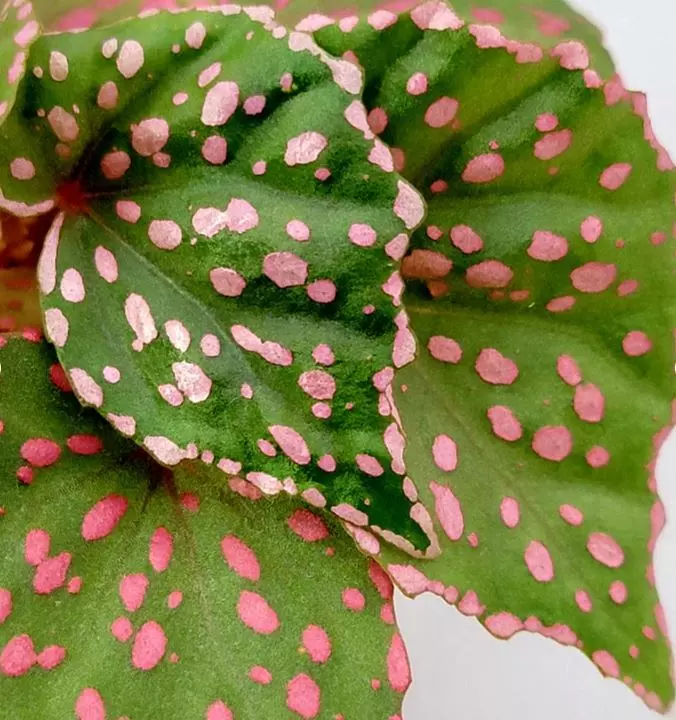
We hope you will take advantage of this article and our advice about Begonia maculata wightii – Polka Dot Begonia Care, Polka Dot Begonia Propagation & How to Propagate Begonia maculata, the Polka Dot Plant
Looking for more gardening articles? Recommended articles for you:
How to Propagate Anthurium Plant Step by Step
How to Propagate a Bird of Paradise Plant Strelitzia








